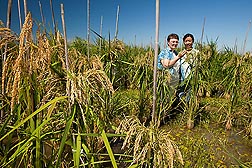USA
June 1, 2013
"Mapping the Way to Even Healthier Rice" was published in the May/June 2013 issue of Agricultural Research magazine.

Rice growing in a flooded field at the Texas A&M AgriLife Research Center, in Beaumont, Texas. Scientists are studying the rice under both flooded and unflooded field conditions to see how differences in soil chemistry caused by flooding affect mineral accumulation in rice grains. Here, ARS geneticist Shannon Pinson (left) and AgriLife technician Yao Zhou inspect rice plants in a flooded rice field at the research center.
With the aid of high-tech tools, Agricultural Research Service and collaborating scientists are closing in on the genes in rice that regulate the uptake and storage of important minerals—a pursuit that could bolster the nutritional value of this cereal grain crop as a staple food for roughly half the world’s population.
Ultimately, the team envisions biofortifying rice using traditional plant breeding methods to develop new varieties whose kernels (grain) boast exceptionally high concentrations of essential minerals, including zinc, iron, and calcium.
Rice is a mainstay of the human diet for good reason. It is a rich source of energy, free of gluten (which causes allergic reactions in some individuals), easy to digest, low in fat, and packed with vitamins, minerals, and other nutrients. Some key elements, however, like iron, are lost when the bran on brown rice is stripped off during milling to produce so-called white rice, notes Shannon Pinson, a plant geneticist with the ARS Dale Bumpers National Rice Research Center in Stuttgart, Arkansas.
“More than 70 percent of the white rice eaten in the United States is ‘enriched,’ meaning that thiamine, niacin, iron, and folic acid have been added to the outside surface of the uncooked white kernels to bring the overall nutritional level up to or higher than that of the whole grain (brown rice) for these vitamins,” write Pinson and coauthors in an article describing their work in the October 2010 issue of the newsletter Texas Rice.
Read the complete article